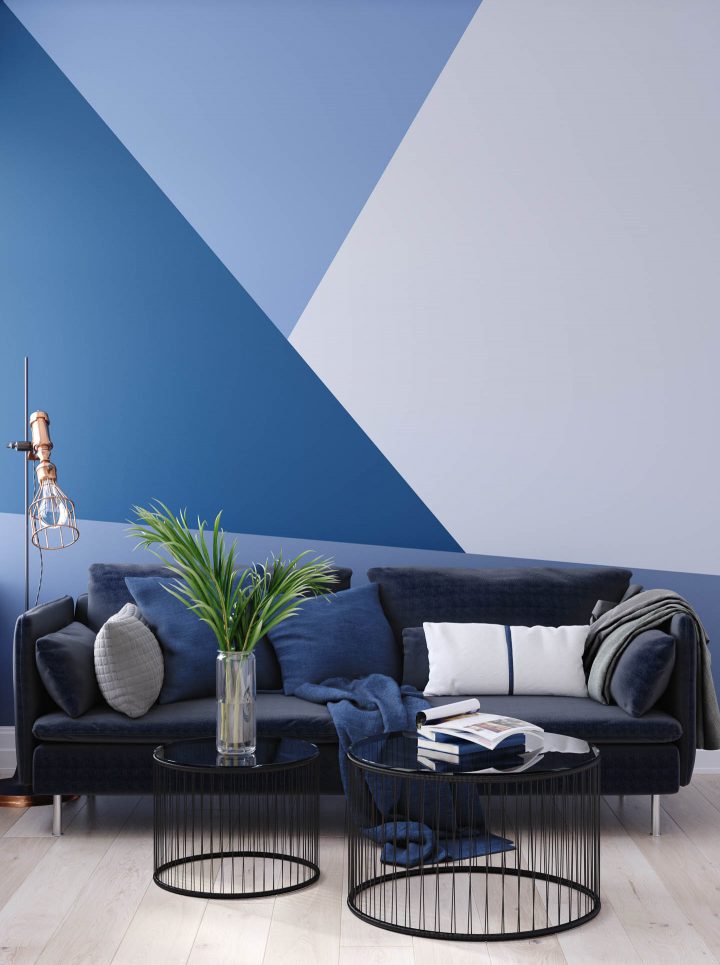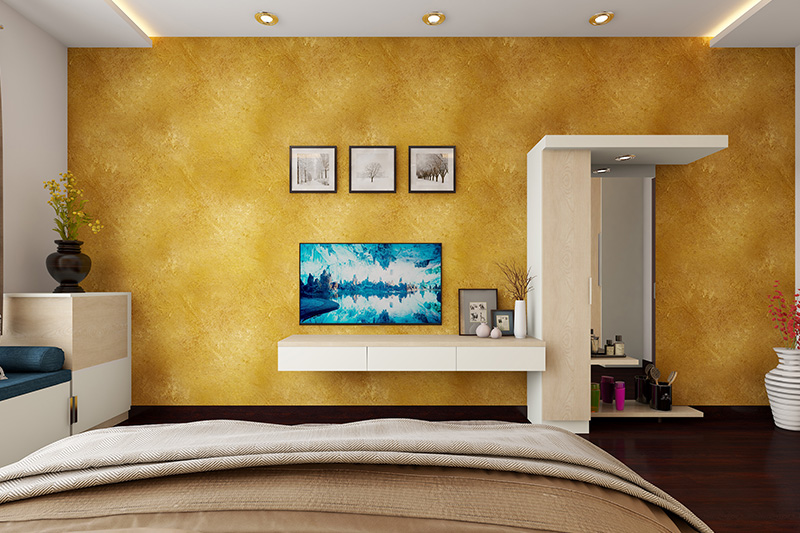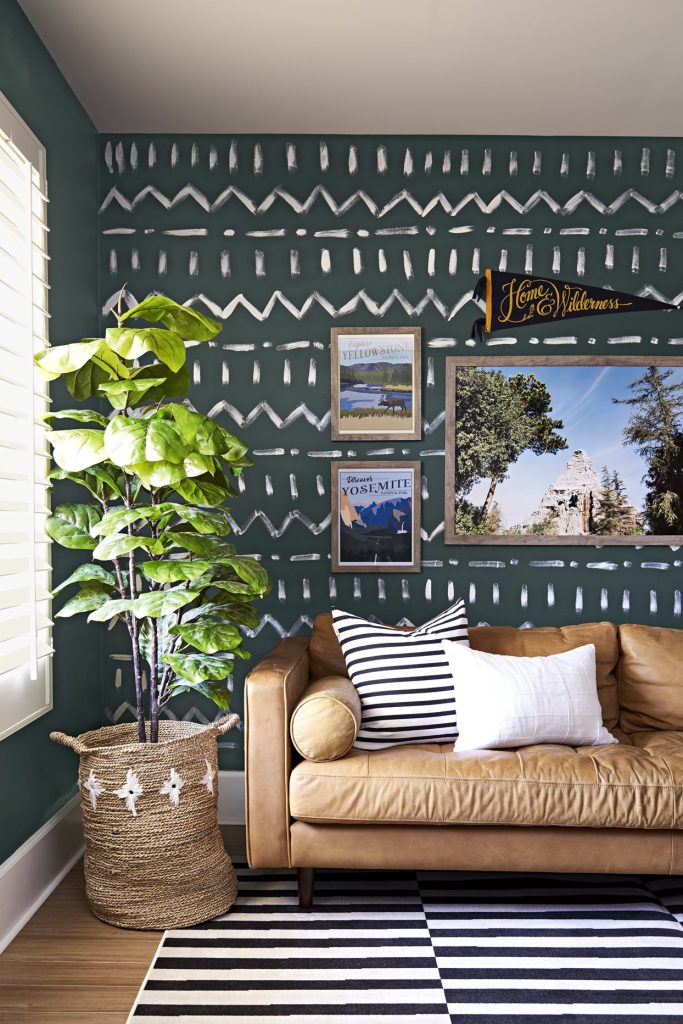Wall paint design has evolved to encompass a wide array of techniques and strategies aimed at enhancing the aesthetic appeal of living spaces. Among these, wall paint designs have emerged as a versatile and impactful means of transforming interiors. From creating visual interest to setting the tone for a room, the application of creative wall paint designs can significantly influence the ambiance and character of a space. In this comprehensive exploration, we will delve into the process of incorporating wall paint designs into interior decor, examining the various techniques, considerations, and creative possibilities that can elevate the design of a home.

The Process of Wall Paint Design in Interior Decor:
Inspiration and Conceptualization:
The journey of incorporating wall paint designs into interior decor often begins with inspiration and conceptualization. Homeowners and designers alike may draw inspiration from various sources, such as nature, art, architecture, or personal experiences. This initial phase involves envisioning the desired atmosphere and visual impact, considering factors such as color palettes, themes, and the overall style of the space.
Selection of Design Elements:
Once the conceptual framework is established, the next step involves selecting the specific design elements that will be incorporated into the wall paint. This may include geometric patterns, murals, textures, gradients, or custom motifs. Each design element contributes to the overall aesthetic and can be tailored to align with the desired theme and mood of the room.

Color Palette and Coordination:
Choosing the right color palette is a crucial aspect of wall paint design. The selection of colors influences the visual impact, mood, and coherence of the space. Homeowners and designers must consider factors such as natural lighting, existing decor, and the intended emotional response when determining the color scheme. Whether opting for monochromatic elegance, bold contrasts, or soothing pastels, the color palette sets the foundation for the entire design.
Surface Preparation and Treatment:
Before the application of wall paint designs, proper surface preparation and treatment are essential. This includes cleaning the walls, addressing any imperfections, and applying suitable primers to ensure an even and durable base for the paint. Additionally, specialized treatments such as textured finishes or faux effects may be considered to introduce depth and tactile interest to the surfaces.

Application Techniques:
The application of wall paint designs encompasses a variety of techniques, each yielding distinct visual outcomes. From freehand painting and stenciling to sponging, ragging, and decorative taping, the choice of application technique depends on the desired design and level of intricacy. Each technique requires precision, skill, and patience to achieve the intended results.
Detailing and Finishing Touches:
Attention to detail is paramount in the execution of sponge paint. Fine-tuning edges, refining transitions between colors or patterns, and ensuring uniformity across the surfaces contribute to a polished and professional finish. Depending on the design, additional detailing such as highlighting, shading, or adding metallic accents may be incorporated to enhance visual interest.
Sealing and Protection:
Upon completion of the wall paint designs, proper sealing and protection measures are essential to preserve the integrity and longevity of the surfaces. Sealants and top coats serve to protect the painted surfaces from wear, moisture, and UV damage, ensuring that the designs retain their vibrancy and allure over time.
Integration with Interior Elements:
The final phase involves integrating the wall paint designs with other interior elements such as furnishings, lighting, and decor. Cohesively blending the painted surfaces with the overall design scheme creates a harmonious and immersive environment, where the wall paint serves as a captivating backdrop that complements and enhances the surrounding elements.
Advantages of wall paint design
The realm of interior design is a rich tapestry of artistic expression and creative innovation, where every element contributes to the visual narrative of a space. Among the myriad techniques and strategies that shape interior aesthetics, wall paint design stands out as a versatile and impactful means of transforming living environments. From evoking mood and ambiance to adding depth and character, creative wall paint designs play a pivotal role in shaping the identity of interior spaces.

Personalized Expression:
One of the most compelling advantages of wall paint lies in its capacity for personalized expression. By incorporating custom-designed motifs, patterns, or murals, homeowners have the opportunity to infuse their living spaces with elements that reflect their individuality, experiences, and aesthetic preferences. Whether it’s a subtle nod to personal passions or a bold statement of creativity, the ability to imbue walls with personalized designs fosters a sense of ownership and unique identity within the home.
Setting the Tone and Mood:
Wall paint designs serve as powerful tools for setting the tone and mood of a room. The choice of colors, patterns, and textures can evoke a wide spectrum of emotions, from serene tranquility to vibrant energy. Through carefully curated designs, homeowners can create spaces that exude warmth, intimacy, dynamism, or serenity, influencing the overall atmosphere and emotional resonance of the environment.
Visual Interest and Focal Points:
Creative garage wall paint have the innate ability to captivate attention and create compelling focal points within interiors. Whether through the use of intricate patterns, striking contrasts, or captivating murals, well-executed wall paint designs draw the eye, infusing rooms with visual interest and engaging the senses. By strategically accentuating specific walls or architectural features, designers can orchestrate visual narratives that enhance the spatial dynamics and allure of a room.
Spatial Transformation and Illusion:
The application of wall paint designs offers the opportunity to transform spatial perceptions and create visual illusions. Through the use of techniques such as color blocking, geometric patterns, or trompe l’oeil effects, designers can alter the perceived dimensions, proportions, and depth of a space. This transformative potential empowers homeowners to redefine the visual dynamics of their interiors, whether by expanding perceived space in compact areas or creating intimate coziness within expansive rooms.

Conclusion:
The process of incorporating wall paint designs into interior decor is a multifaceted endeavor that demands creativity, attention to detail, and a keen understanding of design principles. From the initial stages of inspiration and conceptualization to the meticulous execution and integration with interior elements, each step contributes to the creation of a visually compelling and harmonious living space. Through thoughtful consideration of design elements, color palettes, and application techniques, homeowners and designers can harness the transformative power of wall paint designs to imbue interiors with personality, style, and visual intrigue. Embrace the process of wall paint design to elevate the design of your home and create a space that resonates with creativity and individuality.